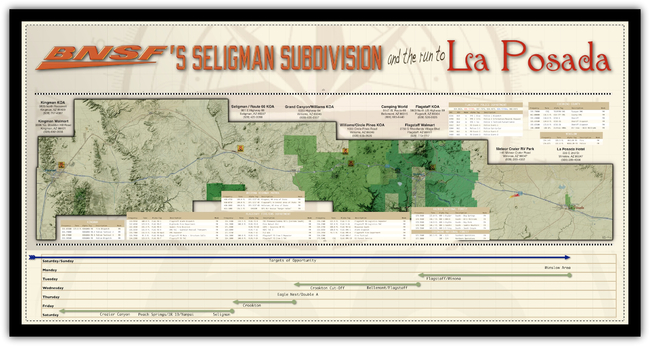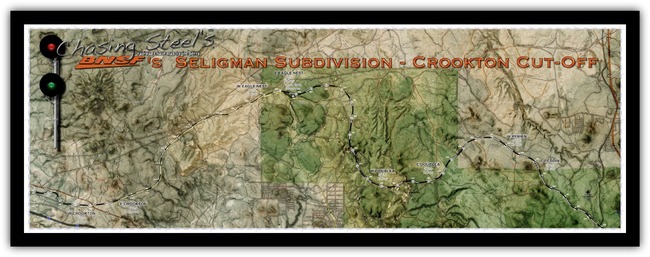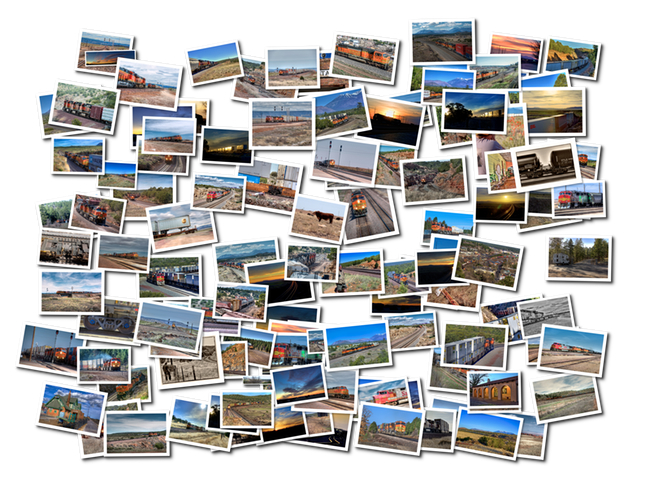Our Best Trip Ever - Part 6 - More Chasing at the La Posada Hotel

(Continued from: Our Best Trip Ever - Part 5 - Chasing at the La Posada Hotel)
Day 2
Track Side at the La Posada Hotel Again
After a nice and luxurious night’s rest at the La Posada Hotel, Deb and I awoke mid-morning to the unmistakeable sound of General Motors’ Electro-Motive Division prime movers of yesteryear. After getting cleaned up, we decided to grab breakfast in the camper before we started the day.
On the way to the camper we discovered the source of the diesel cacophony that was to provide an old-school ambience to our breakfast feast. Working the Winslow Yard, perhaps assembling its train, which I assume it to be the Winslow Local, was a pair of glorious old engines. On the point was the BNSF 120 (formerly ATSF 120), which is an EMD GP60M that was built in June, 1990, as part of the first production run of GP60Ms. The second, and final unit, was the BNSF 2333 (formerly BN 2333 and SLSF 478) which is an EMD GP38-2 that was built a mere 13 ½ years prior (in 12/76) to BNSF 120 and some 34 years ago!

After enjoying a fantastic breakfast burrito, I grabbed my gear and headed track side to catch these old units in action. In some weird way I felt obligated to capture the scene. It felt a little like chasing a steam locomotive except these units were commonplace for me because they ruled the rails back when I started out. It is not that rare of a sight to see on the BNSF today, but what I thought about, as I snapped photo after photo, was the fact that this scene, in particular, was all about predecessors. I suddenly began to feel old.
On September 21, 1995, the Burlington Northern Railroad merged with the Atchison, Topeka and Santa Fe Railway to form the Burlington Northern Santa Fe Railway. The individual roads operated autonomously until December 31, 1996 when the railroads officially joined operations. Then in January, 2005, the railroad’s name was officially changed to “BNSF Railway Company.”
So, here before me, some 15 years after the merger, was a representative unit from each parent railroad — but not just that. Each unit was an “old generation” unit in as complete pre-merger livery as you can get. It was the predecessors of the BNSF Railway and the predecessors of the today’s ubiquitous GE locomotives all rolled up into one. I began to wonder if the BNSF Railway had known I was at the La Posada Hotel and put these two units together for me…ever so briefly!
The EMD GP60M, represented by BNSF 120, was once the pride of the Santa Fe Railroad and held the point on most of the “hot” intermodal and/or piggyback trains of the day. After many years of use and technological advancements in locomotive engineering these units tend to be relagated to switching duties and local jobs these days.
I shot a whole bunch of images as these units continued their work on the east end of Winslow Yard and here is a sampling of that effort:
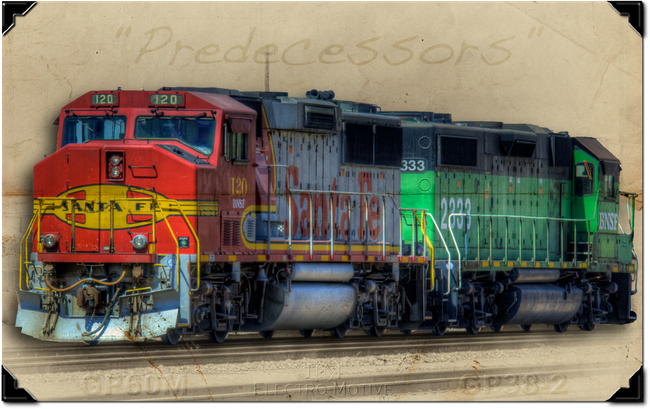 Predecessors
Predecessors
[4/18/2011 - Seligman Subdivision] © Copyright 2011, Joe Perry 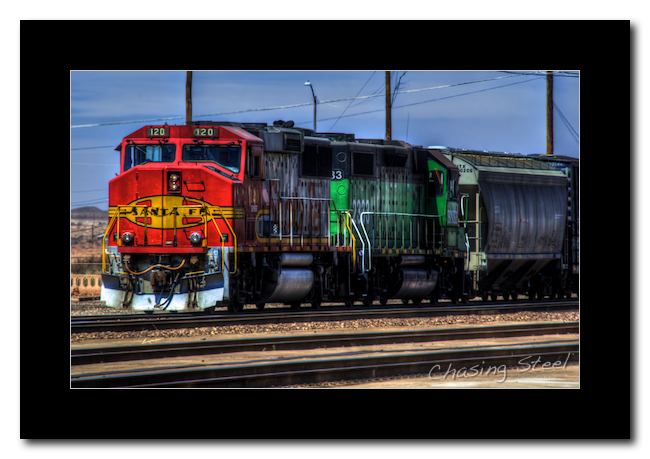 BNSF 120 East - Predecessors for both, the BNSF (Santa Fe & Burlington Northern) and modern locomotives, can be seen in this photo showing BNSF 120 (EMD GP60M) and BNSF 2333 (EMD GP38-2) seen here working at the Winslow Yard in April 2011.
BNSF 120 East - Predecessors for both, the BNSF (Santa Fe & Burlington Northern) and modern locomotives, can be seen in this photo showing BNSF 120 (EMD GP60M) and BNSF 2333 (EMD GP38-2) seen here working at the Winslow Yard in April 2011.
[4/18/2011 - Seligman Subdivision] © Copyright 2011, Joe Perry
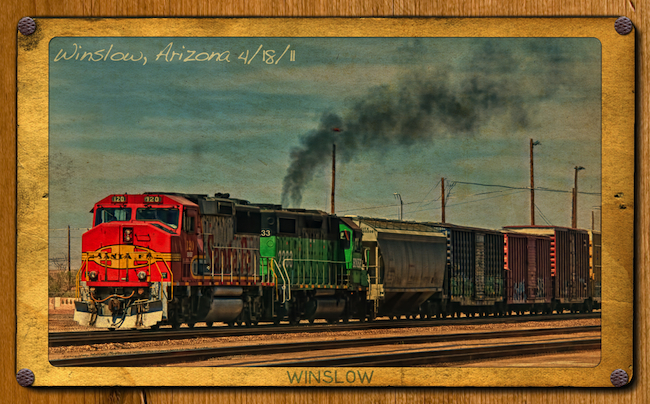 Predecessors Postcard
Predecessors Postcard
[4/18/2011 - Seligman Subdivision] © Copyright 2011, Joe Perry
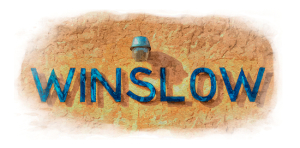
During this period there seemed to a lull in mainline trains coming through Winslow. That didn’t last long though. As the local continued to perform switching moves, a massive unit train, which I presume to be carrying some quarry-based product, came in from the east on track 3 and began stopping for a crew change. Even before the brakes where set on the unit train, which had four units up front, 3 mid-train units and two more on the rear — with a ton of cars, I could see headlights on the horizon in both directions. We were back in business.
I continued to shoot from in front of the Winslow Amtrak station for bit as the traffic picked up. Here is a sequence of a hot intermodal (Z-train) coming in from the east. This train crossed over and came in on Track 2 and stopped ever so briefly and then it was gone again with a new crew.
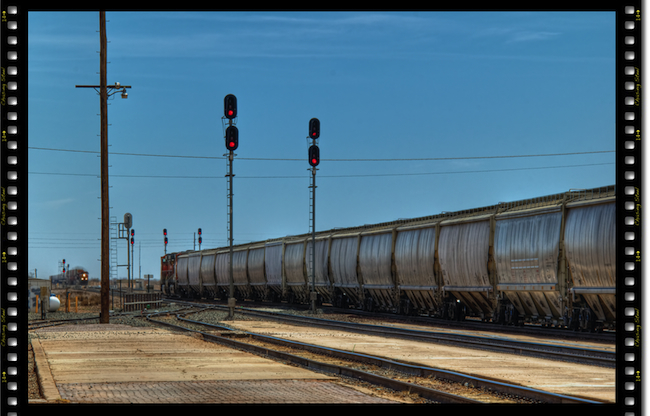
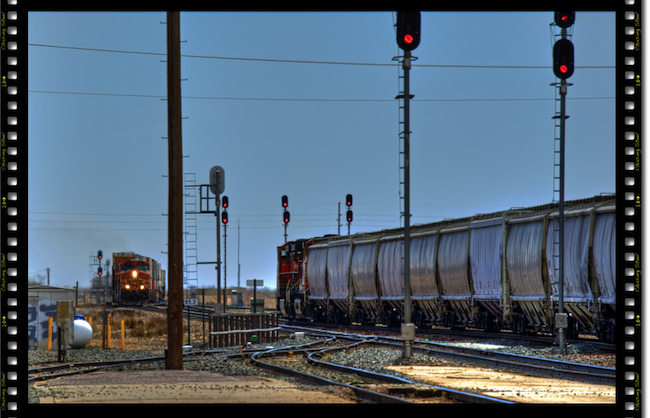
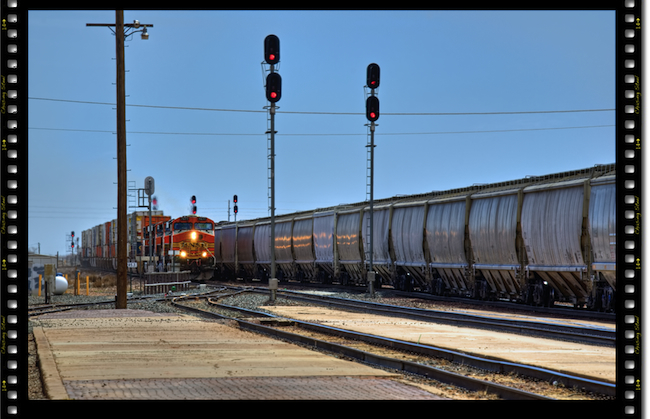 BNSF 7677 West 1, 2, 3 - BNSF 7677 (GE ES44DC), BNSF 4494 (GE DASH 9-44CW), BNSF 6639 (GE ES44C4), and BNSF 7334 (GE ES44DC) hustle this westbound Z-train through a crossover at East Winslow, AZ as they pull along side a massive unit train and into the crew change point at Winslow, AZ
BNSF 7677 West 1, 2, 3 - BNSF 7677 (GE ES44DC), BNSF 4494 (GE DASH 9-44CW), BNSF 6639 (GE ES44C4), and BNSF 7334 (GE ES44DC) hustle this westbound Z-train through a crossover at East Winslow, AZ as they pull along side a massive unit train and into the crew change point at Winslow, AZ
[4/18/2011 - Seligman Subdivision] © Copyright 2011, Joe Perry
My PSA - The Lay of the Land at the La Posada Hotel
The grounds and area surrounding the La Posada Hotel in Winslow, Arizona are an ideal location from which to watch and/or photograph trains along one of the busiest trackage in the southwest. Guests of the hotel are treated to various spots on the hotel’s property where you can find shade, some seating, and a great vantage point. There are some guidelines that you must follow in order to have a hassle-free experience and not become a nuisance for the hotel, the railroad, or other fans.
Remember that the BNSF Railroad’s right-of-way and associated outbuildings, bridges, and signal houses are private property. The railroads take trespassing on their property very seriously and I would caution everyone against trespassing at any level. The BNSF’s crews are required to report all trespassers and, I suspect, the La Posada Hotel wants to keep a good relationship with the railroad, and, as such, has placed signs along the south end of their property to help remind guests that this is a very active mainline and that it is private property. The hotel’s proximity to the mainline is unparalleled and there is no need to trespass onto BNSF property to get a shot or watch the action. Heeding this advice makes it a more enjoyable experience for everyone involved — especially to keep railfans welcome at the hotel and track side.
For those interested, I created the following mash-up showing the locations of key points and photos showing the views of the east and west from the hotel’s grounds. As you can see, there is no reason to enter BNSF’s property:
 The Lay of the Land at the La Posada Hotel - Click image for a larger view (4MB). Use the arrow keys to scroll the image in your browser.
The Lay of the Land at the La Posada Hotel - Click image for a larger view (4MB). Use the arrow keys to scroll the image in your browser.
© Copyright 2011, Joe Perry.
One potentially challenging aspect of the rail photography experience at the La Posada Hotel is the fact that the hotel is situated on the north side of the tracks. This can put the sun directly in front of you and backlight the scene. You can compensate for this with your camera’s settings or shoot multiple exposures. The best thing to do is to shoot when the sun is lower in the sky, like early morning and evening, and shoot activity in the opposing direction.
 Lighting Challenges - While the hotel and depot complex offer an excellent railroad experience it does present a challenge for photographers because the sun is typically on the opposite side of the tracks and this will backlight the scene.
Lighting Challenges - While the hotel and depot complex offer an excellent railroad experience it does present a challenge for photographers because the sun is typically on the opposite side of the tracks and this will backlight the scene.
© Copyright 2011, Joe Perry.
Despite the sunlight challenges, there is some great railroad photographic opportunities to be had at the hotel — not to mention the landscape and architecture opportunities as well. Here are a few shots of traffic directly in front of the hotel’s viewing area:
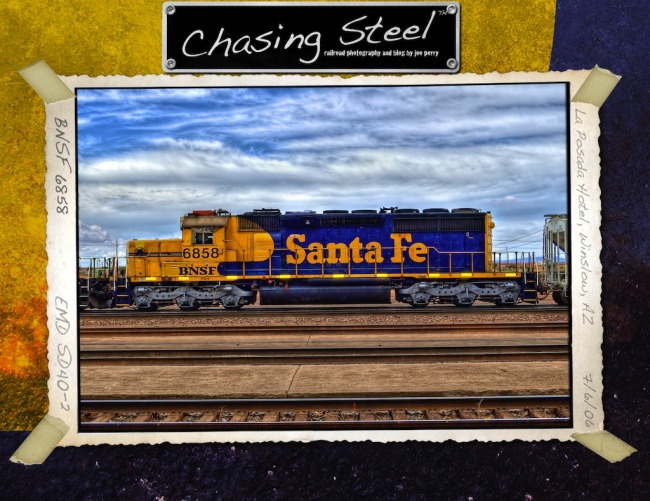 BNSF 6858 - BNSF 6858 (EMD SD40-2 Snoot) is the rear unit in a consist on the point of an eastbound manifest train awaiting a crew change in front of the La Posada Hotel in Winslow, Arizona.
BNSF 6858 - BNSF 6858 (EMD SD40-2 Snoot) is the rear unit in a consist on the point of an eastbound manifest train awaiting a crew change in front of the La Posada Hotel in Winslow, Arizona.
[7/6/2006 - Seligman Subdivision] © Copyright 2011, Joe Perry, ChasingSteel.com
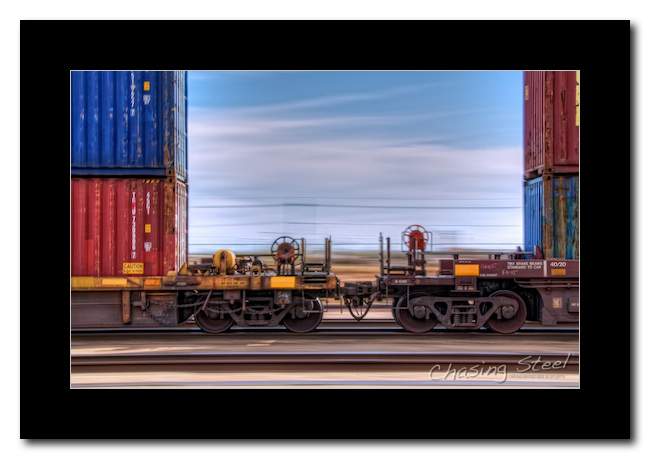 Passing Intermodal
Passing Intermodal
[4/18/2011 - Seligman Subdivision] © Copyright 2011, Joe Perry, ChasingSteel.com.
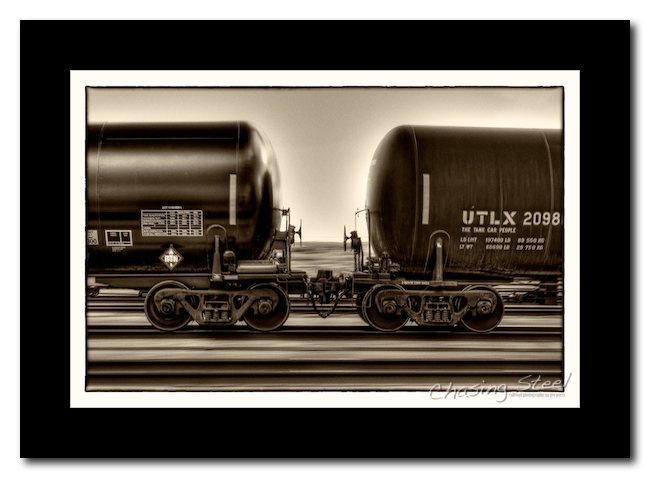 Tank Cars on the Move
Tank Cars on the Move
[4/18/2011 - Seligman Subdivision] © Copyright 2011, Joe Perry, ChasingSteel.com.
After a few more trains and a whole bunch of photos, I wanted a change of venue. I was looking for a less-cluttered scene and opted to walk east of the depot and hotel more towards the control point at East Winslow. After crossing a dry creek or wash I found my quarry that afforded a vantage point with less non-track elements in the scene just east of control point CP 2853 and west of East Winslow.
I could see several trains waiting east of this new location but they held their places for a bit as the sun began to beat down on me. I was getting hot and thirsty but I wanted to wait for at least one train to show up so I wouldn’t waste the effort. I held on long enough for one westbound to reach me before I opted to retreat to the hotel for some eats and treats — and shade!
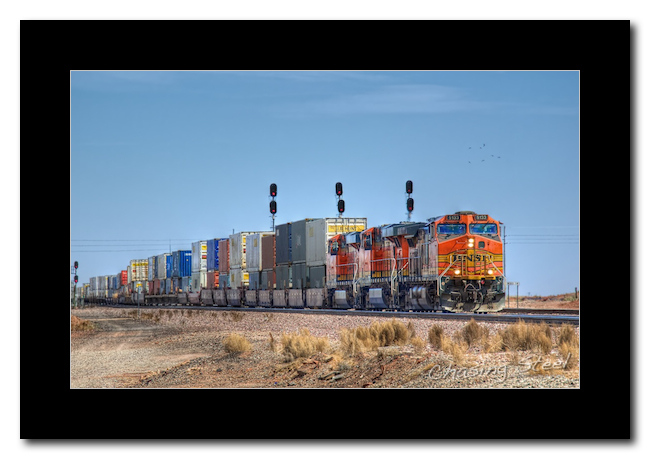 BNSF 5133 West 1 - An apparently fire-damaged BNSF 5133 (GE DASH 9-44CW), BNSF 7588 (GE ES44DC), and BNSF 7671 (GE ES44DC) provide the tractive effort for this westbound intermodal train at CP 2853 just east of Winslow, Arizona.
BNSF 5133 West 1 - An apparently fire-damaged BNSF 5133 (GE DASH 9-44CW), BNSF 7588 (GE ES44DC), and BNSF 7671 (GE ES44DC) provide the tractive effort for this westbound intermodal train at CP 2853 just east of Winslow, Arizona.
[4/18/2011 - Seligman Subdivision] © Copyright 2011, Joe Perry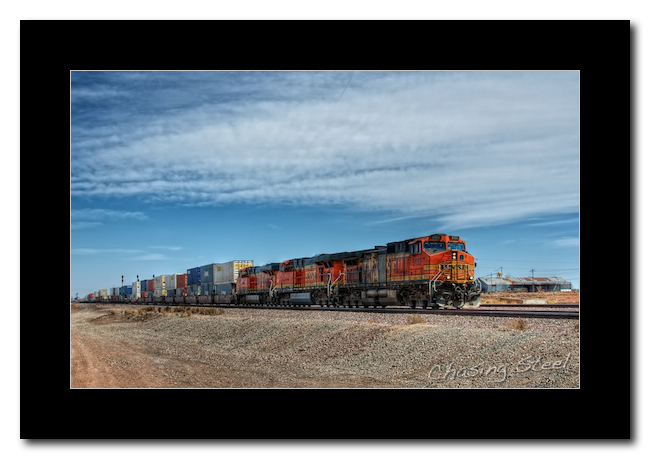 BNSF 5133 West 2 - An apparently fire-damaged BNSF 5133 (GE DASH 9-44CW), BNSF 7588 (GE ES44DC), and BNSF 7671 (GE ES44DC) provide the tractive effort for this westbound intermodal train at CP 2853 just east of Winslow, Arizona.
BNSF 5133 West 2 - An apparently fire-damaged BNSF 5133 (GE DASH 9-44CW), BNSF 7588 (GE ES44DC), and BNSF 7671 (GE ES44DC) provide the tractive effort for this westbound intermodal train at CP 2853 just east of Winslow, Arizona.
[4/18/2011 - Seligman Subdivision] © Copyright 2011, Joe Perry
After a sufficient respite in the camper for some soda, shade, and a good long sit, I headed back to the tracks and continued to ply my trade. It was a great day and it kept getting better.
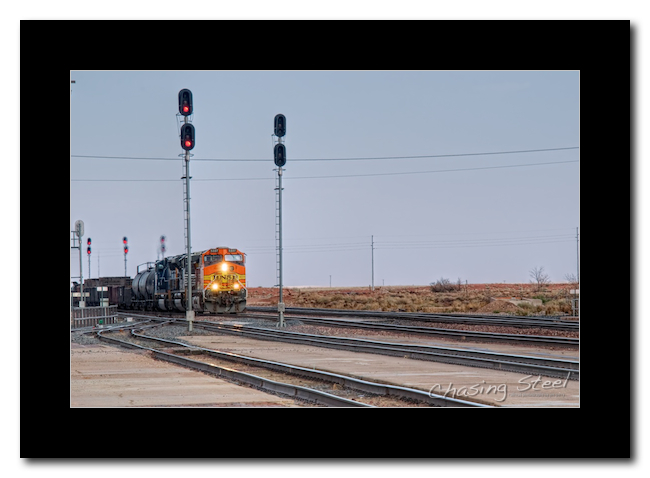 BNSF 5377 West - BNSF 5337 (GE DASH 9-44CW), NS 2771 (EMD SD70M-2) , and CSXT 4811 (EMD SD70MAC) bring their manifest consist into Winslow, AZ after just completing a run across BNSF’s Gallup subdivision.
BNSF 5377 West - BNSF 5337 (GE DASH 9-44CW), NS 2771 (EMD SD70M-2) , and CSXT 4811 (EMD SD70MAC) bring their manifest consist into Winslow, AZ after just completing a run across BNSF’s Gallup subdivision.
[4/18/2011 - Seligman Subdivision] © Copyright 2011, Joe Perry, ChasingSteel.com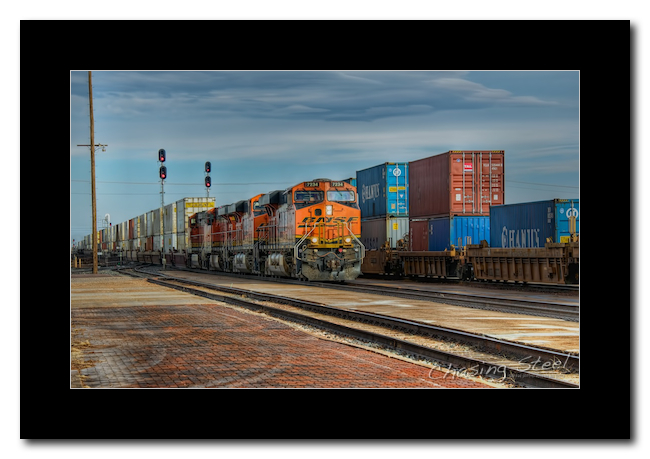 BNSF 7234 West into Winslow - BNSF 7234 (GE ES44DC) leads two other GE ES44DCs and one GE DASH 9-44CW into the crew change point at Winslow, Arizona, having just finished their run over the Gallup Subdivision on April 18, 2011.
BNSF 7234 West into Winslow - BNSF 7234 (GE ES44DC) leads two other GE ES44DCs and one GE DASH 9-44CW into the crew change point at Winslow, Arizona, having just finished their run over the Gallup Subdivision on April 18, 2011.
[4/18/2011 - Seligman Subdivision] © Copyright 2011, Joe Perry, ChasingSteel.com
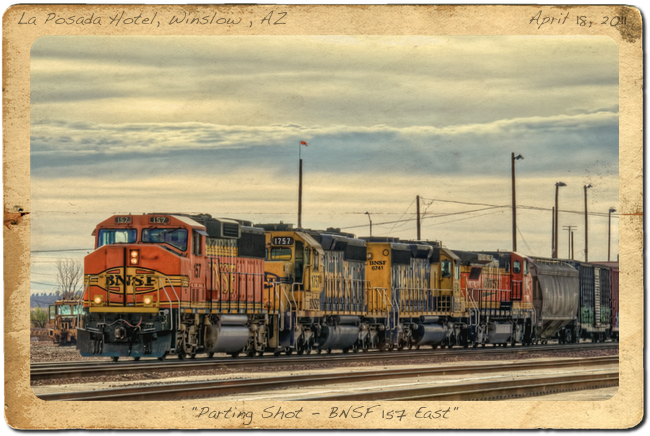 Parting Shot - BNSF 157 East - BNSF 157 (EMD GP60M), BNSF 1757 (EMD SD40-2), BNSF 6741 (EMD SD40-2), and an unidentified GE DASH 9-44CW are performing switching duties at the Winslow Yard late in the day in April 2011.
Parting Shot - BNSF 157 East - BNSF 157 (EMD GP60M), BNSF 1757 (EMD SD40-2), BNSF 6741 (EMD SD40-2), and an unidentified GE DASH 9-44CW are performing switching duties at the Winslow Yard late in the day in April 2011.
[4/18/2011 - Seligman Subdivision] © Copyright 2011, Joe Perry, ChasingSteel.com
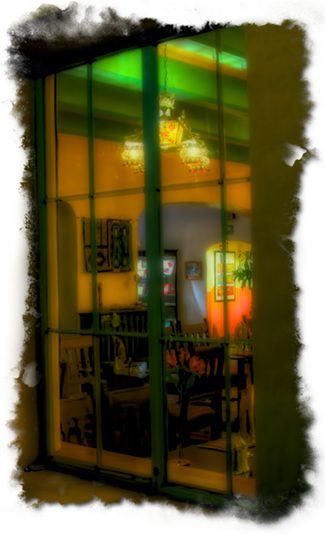
Radar Love and the Turquoise Room
I had a full day of chasing steel and photography and I felt I had some great shots so I decided it was time to wrap it up and meet up with Deb.
I put away my gear in the camper, cleaned the grit off of me and proceeded to walk towards the lobby. Just then I see Deb exited the hotel and I smiled. It seems we have always had that “radar love” that Golden Earring sings about, because she was coming out to see how I was doing at the exact same time.
After we greeted each other and shared our day’s events with one another we decided that it would be remiss of us not to partake of one of the La Posada Hotel’s gems, the Turquoise Room.
The Turquoise Room is one of, if not the best, restaurants in this region of the southwest. It is operated by renowned Chef John Sharpe. It is a fantastic dining experience.
Reservations are recommended but Deb and I neglected to make them earlier. Fortunately, it was still early enough in the evening that we were able to get a window seat that afforded us a view of the tracks - of course!
We went all out on the meal and, at our server’s recommendation, we started with the “Signature Soup” which is best described straight off of their menu (The soup is incredible! I am getting hungry and salivating at the thought it right now!):
Creamy sweet corn in the same bowl with smooth and spicy black bean topped with a signature of spicy chile cream.
In keeping with our railroading theme, Deb and I both had dishes from the “Fred Harvey Dishes” section on the menu. She had the prime rib and I had the filet mignon. Simply amazing. You definitely need to eat here if you are anywhere within 250 miles or so.
End of Day 2
After a terrific meal and dining experience, Deb and I took a brief walk around the hotel’s grounds and interior to soak up all that we could. We love this place and it was to be our last night here. While we were sad that it was coming to an end, we had a great time and we were looking forward to adventures unknown that were still to come as we began to chase the BNSF along the Seligman Subdivision for the next week.
We retired to our room and enjoyed our final night’s stay in the fabulous La Posada Hotel. We will be back soon — no doubt.
Tomorrow we would leave for our chase fully rested and relaxed with some fond memories.


 Arizona,
Arizona,  BNSF,
BNSF,  La Posada,
La Posada,  Maps,
Maps,  Seligman Subdivision,
Seligman Subdivision,  Turquoise Room,
Turquoise Room,  Winslow CATEGORIES:
Winslow CATEGORIES:  General Photography,
General Photography,  Railroad Photography,
Railroad Photography,  Ramblings and Such
Ramblings and Such 
